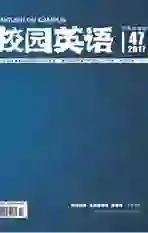The Study of“Slips of the Tongue”in English
2018-01-27杨英马国华李亚琪
杨英 马国华 李亚琪
【Abstract】The scientific analysis of slips of the tongue reemerged in the early 1970s with the seminal publication of an article by Fromkin (1971) that examined the way speech errors may be used in the construction of linguistic arguments. We know that “slips of the tongue” is tightly related to the language production. Hence, when we make slips of the tongue, some process must have gone awry. This paper intends to introduce this special phenomenon so that people can roughly know the “slip of tongue” in English.
【Key words】slip of tongue; properties; types
1. Introduction
To be honest, we definitely do not know the specific process in making the speech errors. However, we have made some accomplishment in this study such as the common properties of speech errors, the types of speech errors. In the next, I will introduce this phenomenon on the basis of some English speech errors.
2. Definition of the “Slips of the Tongue”
A speech error, commonly referred to as a slip of the tongue, is a deviation from the apparently intended form of an utterance. Some people may call it “spoonerism”. Actually, spoonerism is just a type of “slips of the tongue”.A spoonerism is an error in speech in which corresponding consonants, vowels, or morphemes are switched between two words in a phrase. It is named after the Reverend William Spooner, warden of New College, Oxford, who was notoriously prone to this mistake. The classical example of Spoonerism is “you have hissed my mystery lectures. I saw you fight a liar in the back quad. In fact, you have tasted the whole worm”. Hence, “Spoonerism” is a well-known type of speech errors, we should clearly differentiate them.Most of us make similar errors from time to time. Some evidence indicates that such errors are more common when we are nervous or under stress.
3. Types of Speech Errors
Although speech errors cover a wide range of semantic content, there appear to be only a small number of basic types. Examples of the eight types are given in the following Table, with the words that were apparently intended in parentheses.
In “shifts”, one speech segment disappears from its appropriate location and appears somewhere else. “Exchanges” are, in effect, double shifts, in which two linguistic units exchange places. “Anticipations” occur when a later segment takes the place of an earlier one. They differ from shifts in that the segment that intrudes on another also remains in its correct location and thus is used twice. “Perseverations” occur when an earlier segment replaces a later item. “Additions” add linguistic material, whereas “deletions” leave something out. “Substitutions” occur when one segment is replaced by an intruder. These differ from previously described slips in that the source of the intrusion may not be in the sentence. “Blends” apparently occur when more than one word is being considered and the two intended items “fuse” or “blend” into a single item.
If you have closely examined these examples, you probably have noticed by now that these types of errors occur with a number of linguistic units. In some cases, a single phoneme is added, deleted, or moved, but at other times it may be a sequence of phonemes, morphemic affixes and roots, whole words, or even phrases. As a general rule, errors tend to occur at only one linguistic level per utterance. That is, when a person clearly says the wrong word, as in substitutions, the sentence is syntactically, prosodically, and phonologically intact.
References:
[1]David W.Carroll.(1996).Psychology of language.New York: Wadsworth Publishing Company.
[2]王星星.“司馬光砸缸”抑或“司马缸砸光-也谈口误”[J].四川外语学院学报,2005,21(1):64-66.
[3]董俊虹,朱玥.基于语料库分析的英语口误生成规律及内在机制研究[J].西北大学学报(哲学社会科学版),2010,40(1):166-168.endprint
